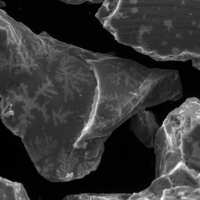amino acids

Revving the Motor: Full-Length Protein Sequencing with Nanopore Technology
Nathan Ni, PhD | Aug 12, 2024 | 4 min read
Jeff Nivala develops nanopore-based sequencing techniques to help advance proteomics.

Expanding the Genetic Alphabet
Kamal Nahas, PhD | Aug 7, 2024 | 5 min read
Synthetic biologists repurposed rarely used codons to install novel amino acids into proteins and expand the capabilities of protein engineering.

Providing Stability In Vivo, In Vitro, and In Culture
The Scientist and MilliporeSigma | Aug 15, 2023 | 3 min read
Albumins enable researchers to bind, sequester, and stabilize important molecules across research applications.

Self Sufficient Cells?
Katherine Irving | Jun 1, 2023 | 4 min read
Animal cells cannot produce 9 of the 20 amino acids they need to function. Some researchers are looking to change that.

Breaking Down Proteins to Build Food Waste Solutions
AltaBioscience | May 16, 2023 | 1 min read
Amino acid analysis helps scientists open the door to new food opportunities for healthier and more environmentally friendly food production.

Rare Autism-Linked Mutation Starves Growing Neurons of Essential Nutrients
Lauren Schenkman, Spectrum | Apr 18, 2023 | 4 min read
The mutation prevents certain amino acids from entering neurons, causing the cells to die early in development.

Cocaine Use Creates Feedback Loop with Gut Bacteria: Mouse Study
Alejandra Manjarrez, PhD | Nov 1, 2022 | 3 min read
A jolt of norepinephrine in the mouse gut facilitates colonization by certain microbes, which in turn deplete glycine, enhancing cocaine-induced behaviors.

Fungal Cold Adaptation Linked to Protein Structure Changes: Study
Patience Asanga | Sep 20, 2022 | 4 min read
Environmental pressure seems to spawn changes in the intrinsically disordered regions of enzymes in polar yeasts, allowing them to adapt to extreme cold.

Study Links Depression with High Levels of an Amino Acid
Dan Robitzski | Jun 14, 2022 | 5 min read
Experiments in animals and observations in humans suggest that the amount of proline circulating in one’s plasma has a strong association with depression severity.

DNA Nanopore Sequencing Adapted for Protein Sequence Comparisons
Sophie Fessl, PhD | Feb 14, 2022 | 3 min read
Researchers link a stretch of DNA to a peptide of interest and measure current changes as the molecule is pulled by a helicase through a nanopore.

Infographic: Reading Proteins with Nanopores
Sophie Fessl, PhD | Feb 14, 2022 | 1 min read
Adapting DNA nanopore sequencing to peptides allows researchers to identify single amino acid differences.

Using Nanopores to Sense and Sequence Proteins
The Scientist | Aug 30, 2021 | 1 min read
Aleksei Aksimentiev and Stefan Howorka discuss challenges in amino acid sensing with nanopores and approaches to design efficient protein sequencing technology.

Cracking Down on Cancer: A Profile of Owen Witte
Diana Kwon | Apr 1, 2020 | 9 min read
Through his studies on cancer-causing viruses, the University of California, Los Angeles, professor has helped develop lifesaving treatments.

Sergiu Pasca Builds Brains to Study Developmental Disease
Emily Makowski | Dec 1, 2019 | 3 min read
The Stanford University professor helped develop a technique to grow brain organoids from induced pluripotent stem cells.

Image of the Day: Fractal Formation
Emily Makowski | Nov 4, 2019 | 1 min read
A mixture of chemicals induces reactions reminiscent of life on pyrite.

Bats May Have Taken on Viruses To Stay in Flight
Ashley Yeager | Feb 22, 2018 | 2 min read
Dampening the immune response to stay up in the air may have helped bats become tolerant to viral infections.

Genes’ Composition Guides More-Optimal Diets
Ruth Williams | Jun 1, 2017 | 2 min read
Fruit flies and mice grow better and eat less when the amino acid balance of their food reflects that coded by their exomes.

A Different Way of Doing Things
Kivanç Birsoy and David M. Sabatini | Apr 1, 2016 | 10 min read
Cancer cells exhibit altered metabolic processes that may serve as promising targets for new therapies.

Metabolic Reprogramming
Kivanç Birsoy and David M. Sabatini | Mar 31, 2016 | 1 min read
How cancer cells fuel their rapid growth
